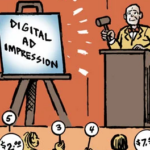 “Data-Driven Thinking” is written by members of the media community and contains fresh ideas on the digital revolution in media.
“Data-Driven Thinking” is written by members of the media community and contains fresh ideas on the digital revolution in media.
Today’s column is written by Mayur Gupta, senior vice president and head of digital at Healthgrades.
Marketing has evolved substantially from the witty and creative ads of the “Mad Men” era to processes designed to drive customer engagement and accelerate business growth. The vast amount of data at our fingertips has made marketing measurable and has better defined its value proposition.
This transformative journey gives marketers a new, shiny object almost each year. But there is one philosophy that has remained true for decades: customer relationship management (CRM). It is not just data, technology or an email channel but the culmination of these pieces combining to deliver a broader customer experience that inspires behavioral change and participation, eventually growing into a “relationship.”
Regardless of how big a brand or marketing budget may be, most marketers say, “We do CRM.” But this mindset has dramatically varying interpretations, implementation and understanding. For some, that means sending promotional emails, direct mail or SMS to a customer segment. Their CRM campaigns are separate from customer marketing or advertising efforts.
Others consider having a database that stores customer information to be CRM, or buying or renting marketing automation software.
But CRM is really about leveraging the customer data and insights beneath every channel and touch point to deliver the most relevant and contextual experience. It’s driving relevant experiences across the customer’s journey, wherever he or she may be that inspires participation.
CRM can also drive cross-selling and upselling by leveraging past behavioral data and predictive models. It can be used to test, learn and understand behavior to determine what inspires it. It’s about connecting the dots across channels to establish a universal understanding of the customer, with the intent to deliver the most seamless, channel-agnostic experiences.
Beyond the data, technology and channel, CRM is a philosophy that drives marketers to provide customers with what they need when they need it – or even before they know they need it. It could be a communication, product or service that offers experiences and values at a time, location and touch point of choice. If executed effectively, CRM can ultimately turn customers into loyalists who maximize the lifetime value for a brand.
To shift marketers’ mindsets that CRM is only about data, technology or software, they must embrace five principles.
CRM Is Not A Channel
CRM should not be treated, organized, planned or executed like a channel. Marketers need to drive customer relationships and meet and exceed expectations wherever their customers may be. They need to leverage customer data and insights from all channels and touch points and deliver the most immersive and relevant experience back through any and all of these channels, inspiring behavior through the journey. That is CRM.
CRM Is Customer Relationship Management
If it helps, marketers should stop calling it “CRM” and start calling it by its full name. The acronym tends to restrict the scope and understanding of its capability. When they expand and think of it as customer relationship management, it is a whole different world. It’s not a thing, but a philosophy that creates an outcome based on many pieces coming together.
CRM Connects To Everything
Marketers cannot establish the CRM capability in a vertical silo; it needs to be a horizontal orchestration within their organizational model that touches and connects with everything they do. The CRM function in a marketing organization cannot just be accountable for customer segmentation and insights related to email and direct mail. The function should establish a universal customer understanding across the ecosystem and drive an always-on seamless conversation with the customer.
CRM Software Is Not Enough
Establishing a lifelong customer relationship and loyalty is not just a technology problem. Marketers need to bring the strategy, data and technology together to establish and operationalize a CRM capability. To do this, they must establish an overarching customer relationship and experience strategy. They need to set a clear definition of the business problem they are trying to solve, identify the customer behavior that is causing that problem and establish the eventual customer experience they intend to deliver to change the behavior.
Marketers must also create a customer data and segmentation strategy that is not isolated by channel. Each customer moves through his or her own unified journey to solve emotional and functional needs. Customers do not differentiate between channels.
It is important to develop a connected marketing technology ecosystem that is focused on gathering customer data from all channels and touch points. It should have the ability within the content publishing engines to leverage data and insight to drive a seamless, relevant and connected experience.
Marketers should define what success looks like via tangible KPIs and a subsequent instrumentation strategy to capture data and measure results. They should also leverage agile ongoing operations to bring all pieces together and communicate, engage and listen repeatedly with agility and nimbleness.
CRM Is All-Encompassing: Think Beyond The ‘CRM Campaign’
We market in a digital world and communicate and engage with customers to meet their emotional and functional needs. This requires data and science behind every conversation with customers, agnostic of channel. We cannot fragment this effort into artificial compartments of a CRM campaign, digital campaign or email campaign. It needs to be one connected, seamless and always-on campaign and experience that uses data and insight for a bidirectional conversation, fulfilling needs and building loyalty.
Advancements in data, technology and media have put the customer at the center, giving them tremendous choice and control, and expectations are high. This leads to a whole new world of customer relationship management as a fundamental strategy and objective that goes way beyond an individual tool, tactic or acronym.
The sooner brands acknowledge and address that, the faster they will evolve.
Follow Mayur Gupta (@inspiremartech) and AdExchanger (@adexchanger) on Twitter.













